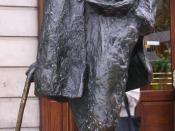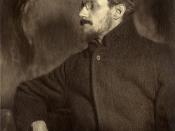When The Spirit Dies, You Are Left With NothingIn James Joyce's "The Dead," a group of people is gathered at the Misses Morkan's annual Christmas season dance. The reader is introduced to a variety of party attendees, all of which seem like perfectly ordinary, everyday people doing normal, everyday activities. However, peeling back the surface layer that is the everyday reveals a much more atypical situation. The title of this story, "The Dead," lays down the foundation for a gruesome undertone. The characters and everything surrounding them appears to be dead or dying, either by withering away from old age, something from within being taken, or the imagery of death repeatedly mentioned. "Dark phrases" (Anspaugh 1) such as "three mortal hours" and "perished alive" (Broadview 90) are used and "have led [many] to suggest that the Morkan's party is a dance of the dead" (Anspaugh 1). This is a party filled with lifelessness.
The Misses Morkans, otherwise referred to as Kate, Julia, and Mary Jane, live in the upper part of a "dark gaunt house on Usher's Island" (Broadview 89). Every year, Mary Jane, the niece of Kate and Julia, played the organ in a church and gave lessons to younger pupils. Every year, Kate "gave music lessons to beginners on the old square piano in the back room." Every year, Julia sang soprano in the Adam and Eve's church choir. And every year, the three women hosted a holiday dance with the same dances and conversation and dinner menu and toasts. Every year, they did the same thing. It is as if the Morkan women were set in some type of trap; one that didn't allow them to live. It was as if they were stuck in this mundane, dead lifestyle; Julia with grey hair and grey "[dark] shadows"...
![[The Voisin brothers, French aviation pioneers. Gabriel Voisin (1880-1973), on the left, and Charles Voisin (1882-1912), on the right] (LOC)](https://s.writework.com/uploads/5/50179/voisin-brothers-french-aviation-pioneers-gabriel-voisin-188-thumb.jpg)

